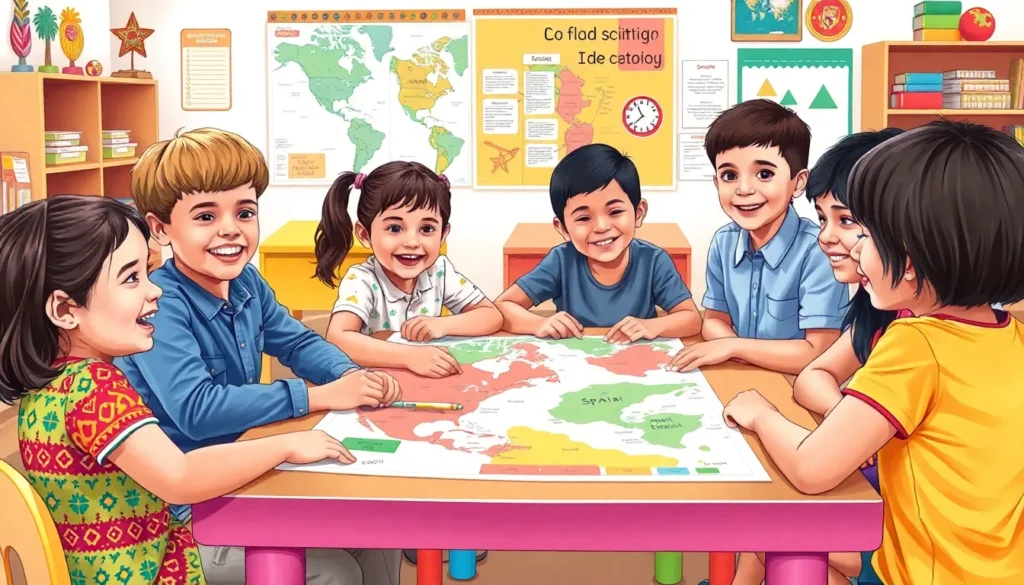In a world that’s more connected than ever, dual language learning isn’t just a trendy buzzword—it’s a superpower. Imagine being able to order tacos in Spanish while discussing quantum physics in English. Sounds impressive, right? This approach to education opens doors to new cultures and enhances cognitive skills, making students not just bilingual but also more adaptable thinkers.
But it’s not all about academic achievements and cultural enlightenment. Learning two languages can turn the average student into a social butterfly, fluttering between different worlds with ease. Plus, who wouldn’t want to impress their friends with their ability to switch between languages like a pro? Dive into the fascinating world of dual language learning and discover how it can transform not just language skills but lives.
Table of Contents
ToggleWhat Is Dual Language Learning?
Dual language learning refers to an educational framework that integrates two languages into the curriculum. This approach combines instruction in a native language with a second language, fostering an immersive learning environment. Students participate in classes where they develop proficiency in both languages through content and communication.
The model promotes bilingualism and biliteracy, allowing students to become fluent in both languages. Cognitive skills often see enhancement, as engaging with different languages requires critical thinking. Cultural awareness also benefits, given the exposure to diverse perspectives and traditions.
Programs can vary widely, with some designed for native speakers of one language paired with learners from another. These models encourage peer interaction, supporting collaboration among students. A common structure includes a 50/50 split of instruction time in each language, but variations exist based on specific educational goals.
Benefits extend beyond language skills. Research indicates that students in dual language programs often perform better academically than their monolingual peers. Engagement in diverse linguistic settings has shown positive effects on social skills, promoting empathy and understanding among students from different backgrounds.
Overall, dual language learning equips students with essential tools for navigating a multicultural world. The educational strategy not only enhances language proficiency but also nurtures personal growth and adaptability. Schools adopting dual language programs contribute to developing future-ready individuals equipped for global citizenship.
Benefits of Dual Language Learning

Dual language learning offers numerous advantages that contribute to academic success and personal growth. It enhances cognitive abilities while fostering social skills and cultural awareness among students.
Cognitive Advantages
Cognitive skills receive a significant boost in dual language programs. Research shows that students who participate in these programs often excel in critical thinking and problem-solving. Engaging with two languages stimulates the brain, improving memory and attention control. Enhanced cognitive flexibility allows students to switch between languages, fostering creativity and innovation. Their ability to analyze complex information improves, setting a strong foundation for future academic success.
Social and Cultural Benefits
Social interactions become more enriching through dual language learning. Students develop empathy and understanding as they connect with peers from diverse backgrounds. Exposure to different cultures broadens their perspectives, promoting inclusivity and respect. Communication skills flourish as they become proficient in multiple languages, facilitating effective collaboration. Stronger relationships form among students, helping them navigate multicultural environments with ease and confidence.
Implementing Dual Language Programs
Implementing dual language programs requires careful planning and collaboration among educators, administrators, and communities. This approach ensures effective bilingual education and cultural exposure.
Key Components
Successful dual language programs feature several key components. Balanced language exposure engages students in both languages equally. Curriculum alignment aligns language instruction with academic content to reinforce learning. Assessment strategies measure progress in both languages, promoting accountability. Family and community involvement strengthens ties, enhancing program support. Finally, fostering a positive classroom environment encourages students to communicate and collaborate in both languages.
Teacher Training and Resources
Teacher training plays a crucial role in dual language program success. Professional development equips educators with strategies for effective language instruction. Resources such as bilingual materials enhance lessons, engaging students in diverse content. Collaboration among teachers supports sharing best practices, ensuring a cohesive approach to language teaching. Access to ongoing training fosters adaptability to student needs and evolving curriculum.
Challenges in Dual Language Learning
Dual language learning presents several challenges that can affect students and educators. Addressing these obstacles ensures better outcomes for all involved.
Common Obstacles
Limited resources affect many dual language programs. Teachers may lack access to bilingual materials. Curriculum misalignment can lead to inconsistent exposure to both languages. Furthermore, varying levels of language proficiency among students create additional complications. Some learners may struggle more than others, leading to frustrations. Cultural misunderstandings can also arise, impacting classroom dynamics. Communication barriers may hinder effective collaboration among students, affecting overall program success.
Strategies for Overcoming Challenges
Effective strategies help navigate obstacles in dual language learning. Implementing regular professional development equips teachers with necessary skills. Aligning curriculum across languages fosters a more cohesive learning experience. Encouraging family involvement strengthens community support and engagement. Providing targeted interventions for struggling students addresses diverse proficiency levels. Creating a welcoming classroom environment promotes inclusivity and reduces misunderstandings. Facilitating peer interactions in both languages enhances collaboration, ultimately leading to improved outcomes in dual language programs.
Dual language learning stands as a transformative educational approach that not only enhances academic performance but also cultivates essential social skills. By immersing students in a bilingual environment, it fosters cognitive flexibility and creativity while promoting cultural understanding.
The benefits extend beyond the classroom as students develop empathy and effective communication skills, preparing them for a diverse world. While challenges exist in implementing these programs, strategic planning and community involvement can lead to successful outcomes.
Ultimately, dual language learning equips students with the tools they need to thrive in an increasingly interconnected society, paving the way for future success in both their personal and academic lives.




